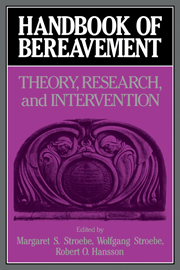Book contents
- Frontmatter
- Contents
- Contributors
- Preface
- Part I Introduction
- Part II The phenomenology and measurement of grief
- Part III Current theories of grief, mourning, and bereavement
- 5 Grief as an emotion and as a disease: A social-constructionist perspective
- 6 Bereavement as a psychosocial transition: Processes of adaptation to change
- 7 Grief: The social context of private feelings
- 8 Bereavement from the perspective of cognitive-experiential self-theory
- Part IV Physiological changes following bereavement
- Part V The psychological, social, and health impacts of conjugal bereavement
- Part VI Grief reactions to different types of loss
- Part VII Coping, counseling, and therapy
- Part VIII Conclusions
- References
- Author index
- Subject Index
5 - Grief as an emotion and as a disease: A social-constructionist perspective
Published online by Cambridge University Press: 04 May 2010
- Frontmatter
- Contents
- Contributors
- Preface
- Part I Introduction
- Part II The phenomenology and measurement of grief
- Part III Current theories of grief, mourning, and bereavement
- 5 Grief as an emotion and as a disease: A social-constructionist perspective
- 6 Bereavement as a psychosocial transition: Processes of adaptation to change
- 7 Grief: The social context of private feelings
- 8 Bereavement from the perspective of cognitive-experiential self-theory
- Part IV Physiological changes following bereavement
- Part V The psychological, social, and health impacts of conjugal bereavement
- Part VI Grief reactions to different types of loss
- Part VII Coping, counseling, and therapy
- Part VIII Conclusions
- References
- Author index
- Subject Index
Summary
The third edition of The Handbook of Social Psychology (Lindzey & Aronson, 1985) contains no references to grief. Rodin (1985), in her contribution to the Handbook, does discuss briefly some of the consequences of bereavement. However, her discussion focuses on the deterioration in health that sometimes follows the loss of social support in general; grief as an emotion is not mentioned. This lack of reference to grief in volumes that presumably represent the state of the art might suggest that grief poses no issues of relevance to social psychology, either theoretically or practically. But such a suggestion has little plausibility. On the theoretical level, grief raises fundamental issues regarding the ties that bind people together and hence that make society possible in the first place. On the practical level, grief places a heavy burden on society, in the form of funeral and mourning rites, care for the bereaved, and so forth.
The neglect of grief by psychologists is by no means universal. During 1985, the same year that The Handbook of Social Psychology was published, 98 articles and books were listed under the heading of grief in Psychological Abstracts. This compares with 27 listings in 1975, 42 in 1980, and 107 in 1990. Most of this burgeoning literature has to do with the clinical aspects of grief. Grief is not only a state of intense personal anguish; it is also associated with increased risk for a wide variety of psychological and somatic disorders. Indeed, the suggestion has been made that grief itself is like a disease (Engel, 1961).
- Type
- Chapter
- Information
- Handbook of BereavementTheory, Research, and Intervention, pp. 77 - 90Publisher: Cambridge University PressPrint publication year: 1993
- 18
- Cited by



